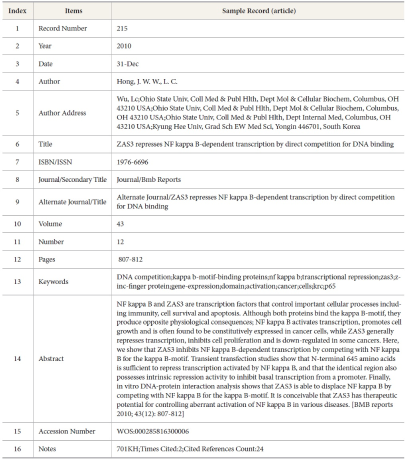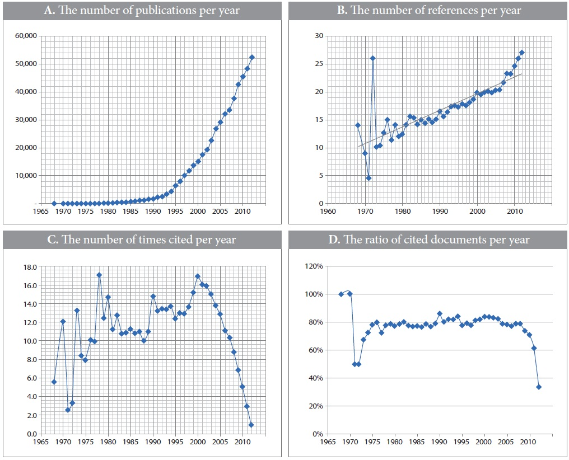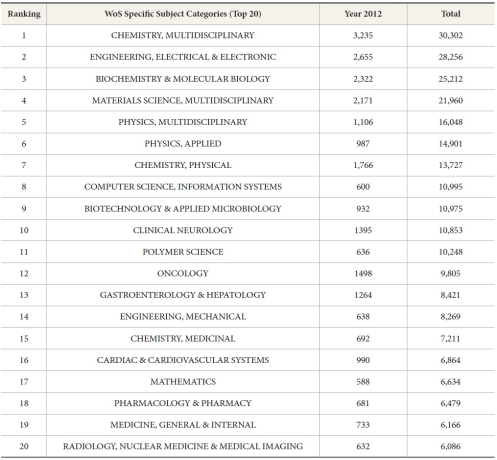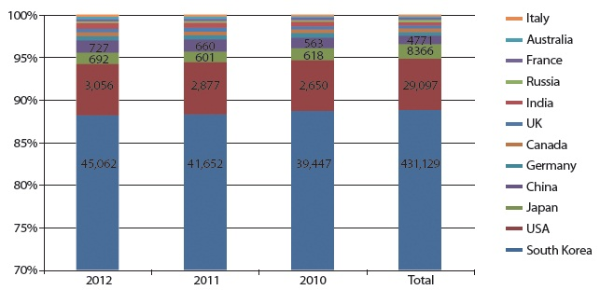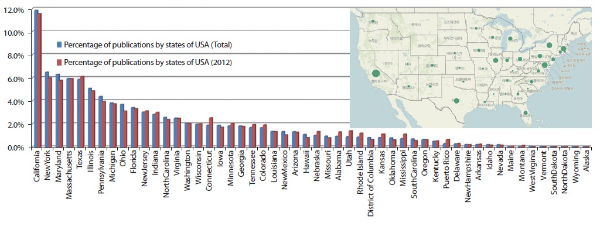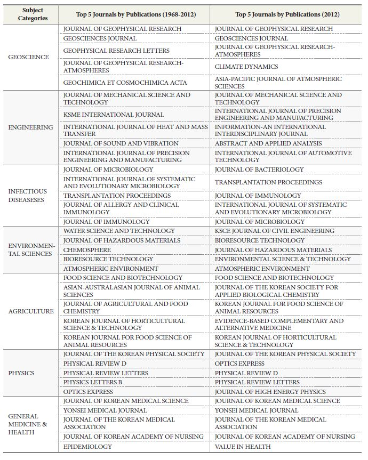JOURNAL OF INFORMATION SCIENCE THEORY AND PRACTICE
- P-ISSN2287-9099
- E-ISSN2287-4577
- SCOPUS, KCI
ISSN : 2287-9099
Korea’s STEM Research Analysis Based on Publications in the Web of Science, 1968-2012

Minho So (Korea Advanced Institute of Science and Technology)

Seon-Heui Choi (Information Service Center, Institute of Science and Technology Information)

Abstract
Korean researchers’ scientific outputs are increasing rapidly with the growth of both Korea’s economy and industry size. This is the time to analyze the scientific output (STEM area) of Korea over the last 40 years. For this analysis, this study used the SCIE database of Web of Science (WoS), which is a representative global Citation Index Service. The objects of analysis are every Korean document published in the SCIE journal, and the research scopes are (1) analysis of citation and subject categories and (2) analysis of co-authorship. Through this study, characteristics such as cited trend and research trend by subject, and the status of collaboration between Korea and other countries including the 50 states of the USA were revealed.
- keywords
- Bibliometrics, STEM research, Web of Science, Korea
1. INTRODUCTION
South Korea (hereafter Korea) is one of the countries that has developed swiftly during the last half century. The number of patents and scholarly publications in the Science, Technology, Engineering and Medicine (STEM) disciplines corresponds with the increase in economy and industry. During the last ten years, the position of Korea’s publications in the WoS SCIE database increased, and moved to 10th place (3.41%) in 2012 compared with 14th place (1.4%) in 2003. Korea is considered a new center for scientific research because of the fast increase of Korea’s scientific output (Leydesdorff & Zhou, 2005). Therefore, the research-to-analysis of international scholarly publications in Korea overall is important.
Scholarly publications such as journal articles are considered representative research products in most STEM disciplines because scholars in their academic communities accept them as a formal scholarly communication channel. These can be used as metric tools of research establishments as well as scholarly communication. The representative method is citation analysis.
Citation analysis is a research method of bibliometrics, which investigates the relationship between cited and citing documents. Citation analysis has been a research area because of its usefulness of the methodology and result. There have been many applications of citation analysis, such as user studies, history of science studies, communication patterns of scientists, evaluation of scientific influence and productivity, information retrieval, collection development, studies of document types or use in a field, studies of research trends, and distribution of information resources (Choi, S-K, 1996). In particular, research using citation analysis such as networks among researchers, integration among academic fields, developmental process of academic fields or research trends, and knowledge maps have been productively performed recently (Cho, H-Y, 2010).
Thomson Reuters’ (previously ISI) WoS is the first citation index database for citation analysis and is the most well-known in the world. Thomson Reuters’ WoS covers a variety of disciplines: Science, Social science, and Arts & Humanities, and supports citation indices such as SCIE, SSCI, and A&HCI (classified by subject respectively). Nowadays, Scopus of Elsevier and Google Scholar also offer competitive service based citation index databases. Recently, some researchers have tried to compare and analyze these databases (Meho & Yang, 2007). Specifically, Thomson Reuters has improved WoS with the mission, “to maintain a database of worldwide scholarly content that helps researchers find the highest quality literature relevant to their work,” (Saha et al., 2003) and the database is used for much research related citation analysis.
We made a choice to utilize WoS because the object of this study is to analyze Korean international scholarly publication produced over the last 40 years. Citation analysis has had limited use in providing basic statistics of citation. However, we focus more on analysis to find out characteristics by subject and co-authorship. Specifically, the objectives of this study are (1) analysis of Korean scholarly publications by citation and subject using the WoS SCIE database, and (2) analysis of co-authorship between Korea and other countries using the WoS SCIE database.
2. RELATED LITERATURE
Researchers all around the globe have continued to measure the scientific performance of countries based on the bibliometric method, but now research related to Asian countries has become important (Zhang & Zhang, 1997; Fukui & Rahman, 2002; Abrizah & Wee 2011; Fu & Ho, 2013). The scope of analysis of this research is generally the distribution of scholarly publications, science disciplines, contributing institutions, and collaboration. Specifically, (Jeenah & Pouris, 2008; Marshakova-Shaikevich, 2006) Thomson Reuters has published research reports about the emerging research front as well as research performance using various measurements, such as the analysis of citation patterns (Thomson Reuters 2008, 2013).
Korean research for the analysis of performance of national scientific output is very similar to that of other countries, but it can be separated into two approaches according to research material. The first approach is to use international scholarly publications as research materials, such as journal publications in WoS or SCOPUS (Kim 2001, 2005; Kim & Noh 2011; NSTC 2011; Kim 2012). The second approach is to utilize national journal publications by national publishers, such as academic societies in various areas (Choi & Kim 2008; Kim & Choi 2008). Recently, researchers have used Korea’s citation index databases, such as KSCI, KCI, and KOMCI, and studies for the comparison of these citation indices is being carried out (Yang & Lee, 2012).
The most recent study on citation analysis of Korean scientific output has been accomplished by using the KSCD (Korea Science Citation Database).1 KSCD was developed in 2001 by KISTI (Korea Institute of Science and Technology Information), and it covers high quality journal articles and citation information by Korean publishers. Through this research, the characteristics of domestic scholarly publications were revealed, such as publication status by subject, citation trend, and co-authorship between universities or research institutions (Choi & Kim, 2012).
The related research in Korea has limitations in focusing on specific areas of science. National journal publications had limited analysis, which made it difficult to discover long term research trends. This study supplements this limitation through using international scholarly publications by Korean researchers during the last 40 years. For the future, utilization of both global citation index databases, such as WoS and SCOPUS, and Korea’s citation index databases, such as KSCD, should be considered to analyze Korea’s scientific performance concretely.
3. DATA COLLECTION AND METHOD
This study focuses on Korean scholarly publications that are indexed by WoS SCIE and uses all types of documents (articles, editorial materials, letters, news items, corrections, notes, and reviews). Other journals’ publications are not considered. In the next study, selection of document types and article types has to be considered, based on related research about document type (van Leeuwen, Thed, & Costas, 2013).
The following steps to retrieve the relevant data were:
-
(1) Thomson Reuters’ EndNote (version 6) is the software tool for publishing and managing bibliographies, which is used to collect data.
-
(2) Using the search feature, the author address field (key word “Korea”) was used as the query command and the citation database “WoS Science Citation Index Expanded (SCI-EXPANDED)” was selected (May 2013).
-
(3) The search retrieved a total number of 493,123 records during the time period 1968-2012. For efficiency, searches and downloads were completed by each year, and repeated 45 times (1968-2012). Specifically, we added the new type for extraction as Excel format to output styles of EndNote Software.
The sample record from the downloaded data is to ascertain the following (See Table 1).
A collected data set was preprocessed to be able to analyze exact detail. For example, the “Author Address” item in Table 1 was split by countries and 50 states in the case of the “USA” to analyze co-authorship in Korean STEM research. North Korea’s publications among collected data were very minimal since there were only 215, so the data was ignored in the analysis. Specifically, all of the journals (8,100) which contain collected data were classified by subject categories, such as 176 specific categories of WoS and Leydesdorff’s 14 subject categories (Leydesdorff & Rafols, 2009). Microsoft Excel and Tableau Public were utilized as tools for analyzing and drawing charts and maps.
The results of this study are based on only Korean scholarly publications that are indexed by WoS SCIE so that the results cannot be interpreted as representative of the complete Korean scientific output.
4. RESULTS
4.1. Analysis of Korean STEM Research by Citation and Subject Categories
The number of publications during the period from 1968 to 1980 is considerably fewer compared to the period after 1980, so that this specific analysis has limitations.
As Fig. 1-A shows, Korean publications during the last 30 years have increased consistently. Specifically, the average rate of increase from 1981 to 2012 is 20% and the median value is 17%. Also, the average rate of increase of the number of references of Korean publications has increased by 3% so that the average number of references of the year 2012 became 27.1.
The average increase rate of times cited is 23%, but from 2006, it has continued to drop as shown in Fig. 1-C. The citation ages (i.e., immediacy, peak-time, and half-time of citation) is considered the reason for this syndrome. The related research based on KSCD investigated citation ages by discipline (Choi & Kim, 2012). However, the research to reveal the exact reason and meaning has yet to be conducted. The average rate of cited percentage as shown in Fig. 1-D remains around 80%, but went down after the year 2000. The reason for this syndrome is possibly also due to the citation ages.
The analysis of Korean publications by subject categories (14 areas) that Leydesdorff suggested is shown in Fig. 2. This shows scientific output was concentrated to some categories like Biomedical Sciences 18%, Chemistry 17%, Material Sciences 13%, Computer Sciences 12%, and Clinical Medicine 11%.
Among the categories with the largest percentage, Chemistry (30.7%→16.0%) and Material Sciences (15.3%→13%) have decreased significantly; on the contrary, the categories that have increased percentage rates are Biomedical Science (11.1%→18.5%), Clinical Medicine (7.7%→10.3%), and Computer Sciences (10.0%→13.2%). Despite sharing a small percentage, the categories that show a large percentage increase rate during the last 30 years are Neurosciences (0.8%→4.4%, 238%), Infectious Diseases (1.3%→2.8%, 152%), Environmental Sciences (1.1%→2.2%, 141%), General Medicine & Health (1.3→2.3%, 137%), and Agriculture (2.2%→3.0%, 133%).
These characteristics discussed above might be related to the distribution by subject of the WoS database, so additional analysis research is required.
Correlation between the number of publications and the average number of times cited was not found, as shown in Fig. 3. The categories where the average number of times cited compared to publications are high are: Physics, Infectious diseases, Environment Science, and Geoscience. On the contrary, the categories where the average of times cited compared to publications are low are: Computer Sciences, Engineering, General Medicine & Health, and Agriculture.
The result of the top 20 sub-categories and the number of publications analyzed by WoS subject categories (176 in STEM areas) is shown in Table 2. Top 5 journals by subjects and publications are described in Appendix A.
4.2. Analysis of Co-authorship in Korean STEM Research
The number of authors has increased between 1968 and 2012, and the average number of authors per document is 11.4. The result of the analysis for corresponding authors’ nationality is shown in Fig. 4.The percentage of publications with Korean corresponding authors investigated is 87%, which is a much higher rate than the percentage of other nationalities. Because the majority of corresponding authors are Korean, this indicates that Korean researchers played a leading role in their publications. The next highest percentages of corresponding authors from other countries are as follows: the USA, Japan, China, and so on. Specifically, the percentage of corresponding authors’ nationality in China has increased recently. This would be related to the increase in China’s publications in the WoS SCIE database to 2nd place (12.09%) in 2012 compared to 6th place (1.4%) in 2003. However, further specific research to find the exact reason is required.
The result of analysis for co-authorship with a major county or a group of countries is shown in Fig. 5. Korean researchers share 75% of independent publications and co-authorship is the highest with G7 countries (USA, UK, France, Germany, Italy, Canada); specifically, collaboration research was high among all of the countries. Also, when investigated, it was found that collaborative research (co-authorship) with BRICs (Brazil, Russia, India, China) countries has also increased rapidly. Furthermore, co-authorship has increased between Korea and China consistently, but on the contrary, co-authorship with Japan has continued to decrease. As a result, the ratio of co-authorship has changed. Additional research is required to find the exact reason for this trend.
The result for analysis of co-authorship in scholarly research between Korea and the 50 states in the USA, and the District of Columbia and Puerto Rico, is shown in Fig. 6. The state in the USA that made the most research in publications was found to be California (total number of publications: 13,403; 2012 number of publications: 1,810) and other states such as New York, Maryland, Massachusetts, and Texas followed. The duplication which occurs from co-authorship between Korea and one or more states of the USA were not excluded in Fig. 6.
Fig. 5
Percentage of Co-Authorship with Major Countries or a Group of Countries Every 5 Years (1982-2012)
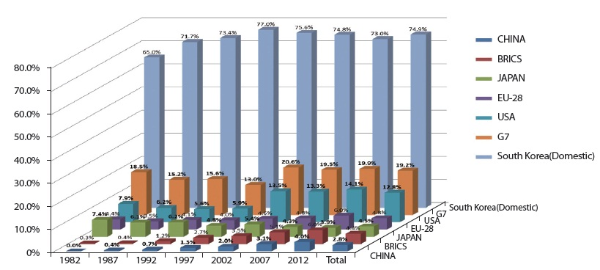
The last analysis of this study is the investigation for the ratio of co-authorship with other countries by discipline (14 subject categories). The major disciplines that show a high ratio with other countries are Physics (38%), Environment Sciences (38%), Ecology (49%), and Geoscience (55%). The 10 other disciplines share a ratio composed of over 70% of independent research by Korean researchers. Specifically, the ratio of Clinical Medicine discipline was analyzed as 85%.
5. DISCUSSION AND CONCLUSION
This study analyzes only those journal publications which researchers consider to be the most representative and trustworthy for analyzing Korean researchers’ scientific output in STEM using bibliometric methods during the last 40 years. Specifically, Thomson Reuters’ WoS SCIE database is used for citation analysis and EndNote software is utilized to collect the data set. The objective of the research is first, analysis of citation and subject categories and second, analysis of co-authorship. For this, the collected data was pre-processed to add subject classifications on journals using Leydesdorff and WoS subject categories.
The findings of the study are as follows:
-
(1) After 1980, the number of Korean researchers’ publications in STEM has increased 20% on average, and the average increase of the number of references was 3%. Also, the average increase in times cited with respect to the estimation of the quality was 23% and the ratio of cited publications was 80%; however, both these numbers have decreased since 2000. The main cause of this is attributed to the citation ages (i.e., immediacy, peak-time, and half-time of citation), but related research is required to find the exact reason.
-
(2) The publications were concentrated on disciplines such as Biomedical Sciences (18%), Chemistry (17%), Material Sciences (13%), Computer Sciences (12%), and Clinical Medicine (11%), and this portion shared 70%.
-
(3) After 1980, the discipline with the highest percent decrease in publications, among other disciplines, was Chemistry (30.7%→16.0%). On the other hand, the discipline with the highest percent increase was Biomedical Science (11.1%→18.5%).
-
(4) Correlation between the number of publications and the average of times cited was not found. The category where the average of times cited is high was Chemistry (11.8); on the other hand, the category where the average of times cited is low was Engineering (5.7).
-
(5) The percentage of publications of corresponding authors by country was in the following order: Korea (87%), USA (7%), Japan, and China, but China overtook Japan during the last two years.
-
(6) Independent publications by Korean researchers share 75% and co-authorship is the highest with G7 countries (USA, UK, France, Germany, Italy, Canada); specifically, collaboration research was high among all of the countries. Also, the syndrome known as collaborate research (co-authorship) with BRIC (Brazil, Russia, India, China) countries has rapidly increased. Specifically, co-authorship has increased between Korea and China consistently. China’s increase overtook Japan during the past two years.
-
(7) As a result from the analysis of co-authorship between Korea and 50 states in the USA, the state which made the most research in publications was California (12%).
-
(8) The categories which are high in the ratio of co-authorship with other countries are Physics (38%), Environment Sciences (38%), Ecology (49%), and Geoscience(55%). Whereas, the other 10 disciplines share over 70% of the ratio of independent research by Korean researchers. Specifically, the category in which the ratio of independent research by Korean researchers is the highest was investigated.
For the future, the utilizing of other databases such as KSCD should be considered because this research limited the analysis scope to only the SCIE database. Specifically, as a result from other recent analysis of the composition (rate) by subject between KSCD and SCIE, two compositions were considerably different (Choi & Kim 2013). Therefore, comparison with KSCD is required to analyze Korea’s scientific performance completely.
- 투고일Submission Date
- 2013-11-18
- 수정일Revised Date
- 게재확정일Accepted Date
- 2014-03-06
- 505다운로드 수
- 1,445조회수
- 0KCI 피인용수
- 0WOS 피인용수

